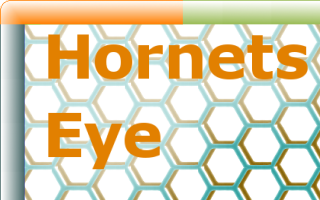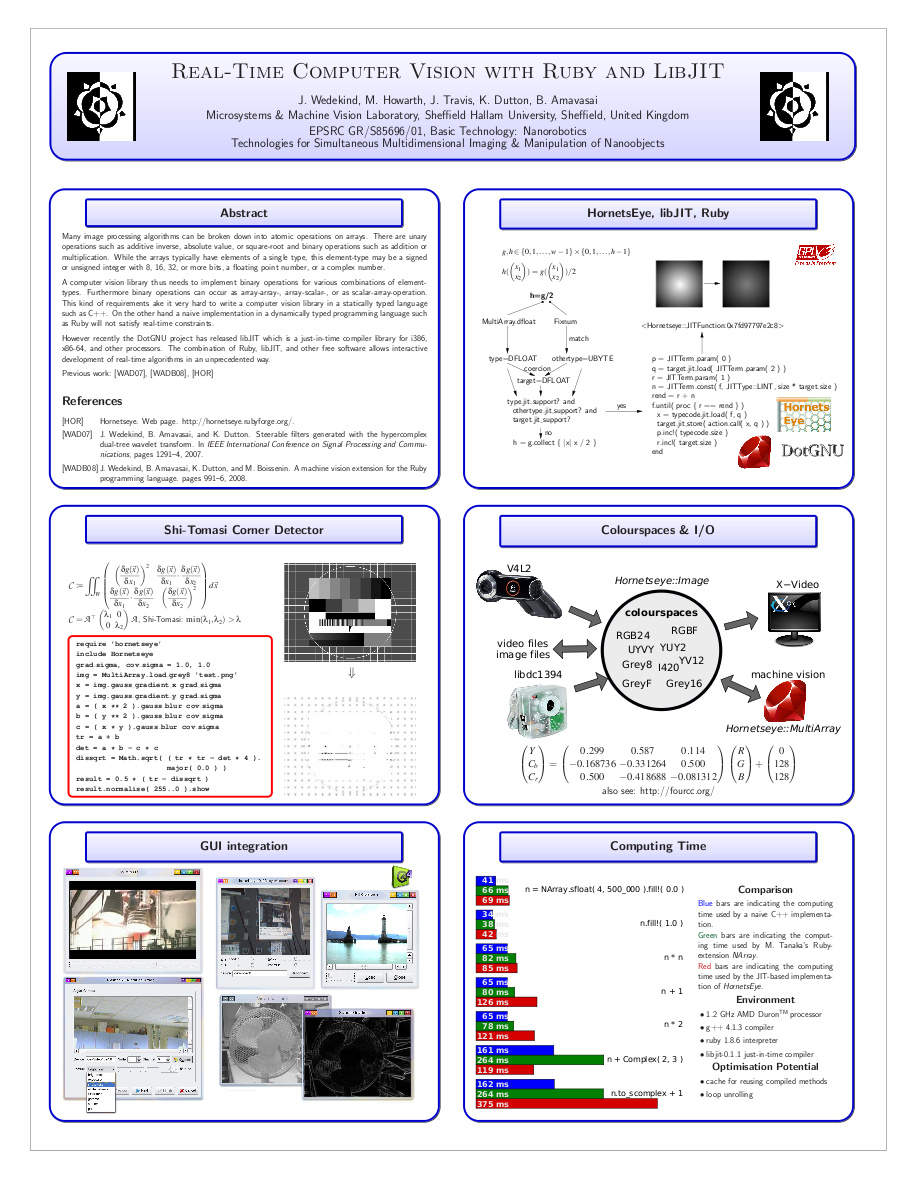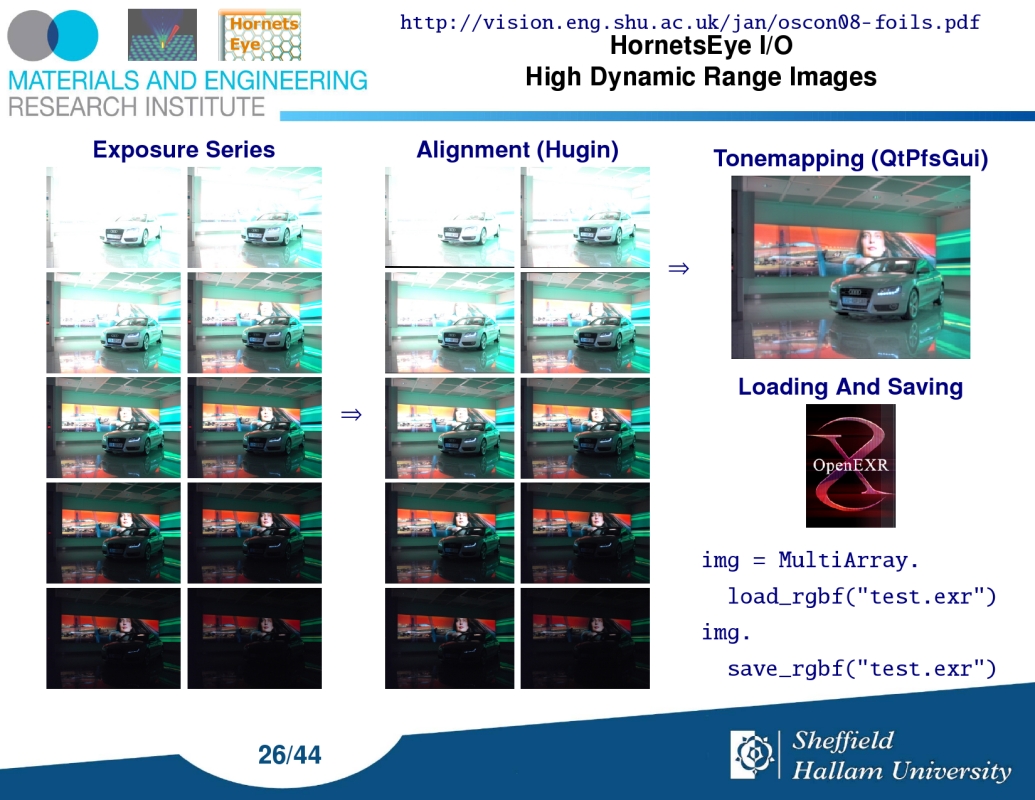|
|
| (145 intermediate revisions by one user not shown) |
| Line 1: |
Line 1: |
| − | [[Image:Hornetseye.jpg|thumb|200px|right|Logo of Hornetseye-library showing a hornet]]
| + | {|align="right" |
| − | =Introduction=
| + | |
| − | '''[http://www.wedesoft.demon.co.uk/hornetseye-api/ HornetsEye]''' is a [http://www.rubyist.net/~nobu/ruby/Ruby_Extension_Manual.html Ruby-extension] for real-time computer vision under GNU/Linux offering interfaces to do image- and video-I/O with [http://rmagick.rubyforge.org/ RMagick], [http://www.xinehq.de/ Xine], firewire digital camera ([http://damien.douxchamps.net/ieee1394/libdc1394/ DC1394]) and video for Linux ([http://www.exploits.org/v4l/ V4L]).
| + | |
| − | | + | |
| − | '''[http://www.wedesoft.demon.co.uk/hornetseye-api/ HornetsEye]''' also is an attempt to use the Mimas library and create a ''minimalistic'' and ''consistent'' real-time computer vision library.
| + | |
| − | * '''minimalistic''': The library is focused on real-time computer vision. Existing libraries are being made used of.
| + | |
| − | * '''consistent''':: A non-redundant set of data-types is used. Also the library tries to stay consistent with existing libraries.
| + | |
| − | | + | |
| − | =Example=
| + | |
| − | The example program performs two-dimensional object recognition with three degrees of freedom. This is a customised algorithm which only works on images showing a single object which can be detected using colour-segmentation. In a controlled environment however this algorithm can be very useful as it is easy to implement. It is also possible to optimise it for real-time applications.
| + | |
| − | | + | |
| − | <pre>
| + | |
| − | #!/usr/bin/ruby
| + | |
| − | # Detect location and rotation of an object using color-segmentation and
| + | |
| − | # principal component analysis on resulting binary image.
| + | |
| − | require 'hornetseye'
| + | |
| − | require 'matrix'
| + | |
| − | raise "Syntax: test4.rb [media resource location]" if ARGV.size != 1
| + | |
| − | input = Hornetseye::XineInput.new( ARGV[0] )
| + | |
| − | # Object is black.
| + | |
| − | dominant = 0
| + | |
| − | frame = 0
| + | |
| − | old_eigenvector = Vector[ 1, 0 ]
| + | |
| − | while input.status?
| + | |
| − | # Read image.
| + | |
| − | img = input.read_grey
| + | |
| − | # Detect center and rotation of object using principal component analysis.
| + | |
| − | # Assuming object has a principal axis (otherwise this approach fails).
| + | |
| − | c = 0
| + | |
| − | n = 0
| + | |
| − | sum = [ 0, 0 ]
| + | |
| − | squares = [ [ 0, 0 ], [ 0, 0 ] ]
| + | |
| − | img.each do |v|
| + | |
| − | if v & 0xE0 == dominant
| + | |
| − | x = c % img.shape[1]
| + | |
| − | y = c / img.shape[1]
| + | |
| − | sum[ 0 ] += x
| + | |
| − | sum[ 1 ] += y
| + | |
| − | squares[ 0 ][ 0 ] += x * x
| + | |
| − | squares[ 0 ][ 1 ] += x * y
| + | |
| − | squares[ 1 ][ 0 ] += y * x
| + | |
| − | squares[ 1 ][ 1 ] += y * y
| + | |
| − | n += 1
| + | |
| − | end
| + | |
| − | c += 1
| + | |
| − | end
| + | |
| − | sum = Vector[*sum]
| + | |
| − | squares = Matrix[*squares]
| + | |
| − | center = sum * ( 1.0 / n )
| + | |
| − | covariance = ( n * squares -
| + | |
| − | sum.covector.transpose*sum.covector ) / ( n ** 2 ).to_f
| + | |
| − | # "abs" is needed to deal with numerical errors.
| + | |
| − | discriminant = ( covariance.trace ** 2 - 4 * covariance.determinant ).abs
| + | |
| − | # Take smallest eigenvalue. Eigenvalues are "0.5 * ( tr +- dissqrt)"
| + | |
| − | lambda1 = 0.5 * ( covariance.trace + Math.sqrt( discriminant ) )
| + | |
| − | eigenspace = covariance - lambda1 * Matrix.unit( 2 )
| + | |
| − | # Compute eigenvector by projecting basis-vectors.
| + | |
| − | projected1 = eigenspace * Vector[1,0]
| + | |
| − | projected2 = eigenspace * Vector[0,1]
| + | |
| − | if projected1.r >= projected2.r
| + | |
| − | projected = projected1 * ( 1.0 / projected1.r )
| + | |
| − | else
| + | |
| − | projected = projected2 * ( 1.0 / projected2.r )
| + | |
| − | end
| + | |
| − | eigenvector = Vector[ -projected[ 1 ], projected[ 0 ] ]
| + | |
| − | # Resolv ambiguity by comparing with previous eigenvector.
| + | |
| − | if old_eigenvector.inner_product( eigenvector ) < 0
| + | |
| − | eigenvector = Vector[ projected[ 1 ], -projected[ 0 ] ]
| + | |
| − | end
| + | |
| − | old_eigenvector = eigenvector
| + | |
| − | gc=Magick::Draw.new
| + | |
| − | pointer=center+eigenvector*30
| + | |
| − | gc.fill_opacity(0)
| + | |
| − | gc.stroke('red').stroke_width(3)
| + | |
| − | gc.circle(center[0],center[1],pointer[0],pointer[1])
| + | |
| − | gc.line(center[0],center[1],pointer[0],pointer[1])
| + | |
| − | result=img.to_magick
| + | |
| − | gc.draw(result)
| + | |
| − | result.to_hornetseye.save( ( "%08d" % frame ) + ".jpg" )
| + | |
| − | frame += 1
| + | |
| − | end
| + | |
| − | </pre>
| + | |
| − | {|align="center" | + | |
| | |- | | |- |
| − | |[[Image:Polygon134.jpg|thumb|320px|135th input frame acquired from the [http://vision.eng.shu.ac.uk/jan/polygon.avi test-video] showing a polygon]]||[[Image:Polyresult134.jpg|thumb|320px|Resulting image indicating position and orientation of the object's principal axis]] | + | |[[Image:AVA-Bristol-2008.jpg|thumb|240px|[http://vision.eng.shu.ac.uk/jan/ava-bristol-2008.pdf Poster] for the 2008 [http://hlsweb.dmu.ac.uk/ava/meetings/bristol2008.html AVA meeting] in Bristol]] |
| | + | |- |
| | + | |[[Image:Oscon08foils.jpg|240px|thumb|Conference presentation [http://vision.eng.shu.ac.uk/jan/oscon08-foils.pdf Real-time Computer Vision With Ruby] presented at [http://en.oreilly.com/oscon2008/ OSCON 2008]]] |
| | |- | | |- |
| | |} | | |} |
| − | | + | =Introduction= |
| − | Thanks to [http://www.mach.uni-karlsruhe.de/seite10513.php Prof. Dr.-Ing. Christoph Stiller] for pointing out this algorithm.
| + | '''[http://www.wedesoft.demon.co.uk/hornetseye-api/ HornetsEye]''' is a Ruby-extension for developing video processing and real-time computer vision software under GNU/Linux offering interfaces to do image- and video-I/O with RMagick, Xine, firewire digital camera, and video for Linux. A new class of unprecedented solutions and a new way of working becomes conceivable when applying a dynamically typed, object-oriented language like Ruby to computer vision. |
| − | | + | |
| − | =Downloads= | + | |
| − | ==HornetsEye-0.10==
| + | |
| − | * [[Image:Hornetseye.jpg|48px]] '''Download [http://rubyforge.org/frs/?group_id=2714 HornetsEye-0.10] released on February 1st 2007'''
| + | |
| − | * [http://vision.eng.shu.ac.uk/jan/polygon.avi test-video with polygon]
| + | |
| − | | + | |
| − | ===Release Notes===
| + | |
| − | See http://www.wedesoft.demon.co.uk/hornetseye-api/ for installation instructions.
| + | |
| − | | + | |
| − | ===Change log===
| + | |
| − | * Made display method accept more element-types.
| + | |
| − | * Normalisation also works on blank image.
| + | |
| − | | + | |
| − | ==Older releases==
| + | |
| − | See [http://rubyforge.org/frs/?group_id=2714 Hornetseye page at Rubyforge] for older releases.
| + | |
| | | | |
| | =See Also= | | =See Also= |
| − | * [[Mimas]] | + | * [[Interactive Presentation Software]] |
| | + | * [[Just-in-time compiler]] |
| | + | * [[Lucas-Kanade tracker]] |
| | + | * [[Hypercomplex Wavelets]] |
| | + | * [[Qt4-QtRuby installer for Microsoft Windows]] |
| | + | * [[TEM vision software]] |
| | + | * [[Image:Mimasanim.gif|40px]] [[Mimas]] |
| | | | |
| | =External Links= | | =External Links= |
| − | * [http://www.wedesoft.demon.co.uk/hornetseye-api/ Hornetseye homepage] | + | * [[Image:Hornetseye.png|48px]] [http://www.wedesoft.demon.co.uk/hornetseye-api/ HornetsEye homepage] |
| − | * [http://rubyforge.org/projects/hornetseye/ Hornetseye at Rubyforge] | + | * [[Image:Rubyforge.png|75px]] [http://rubyforge.org/projects/hornetseye/ HornetsEye at Rubyforge] |
| − | * [[Image:Ruby.png|25px]] [http://www.ruby-lang.org/ Ruby] programming language | + | * [[Image:Sourceforge.png|58px]] [http://sourceforge.net/projects/hornetseye/ HornetsEye at Sourceforge] |
| | + | * [[Image:Swig.png|48px]] [http://www.swig.org/ SWIG] (Simplified Wrapper and Interface Generator) |
| | + | |
| | + | {{AddThis}} |
| | | | |
| | [[Category:Projects]] | | [[Category:Projects]] |
| | [[Category:Nanorobotics]] | | [[Category:Nanorobotics]] |
 Mimas
Mimas
 HornetsEye homepage
HornetsEye homepage
 HornetsEye at Rubyforge
HornetsEye at Rubyforge
 HornetsEye at Sourceforge
HornetsEye at Sourceforge
 SWIG (Simplified Wrapper and Interface Generator)
SWIG (Simplified Wrapper and Interface Generator)

